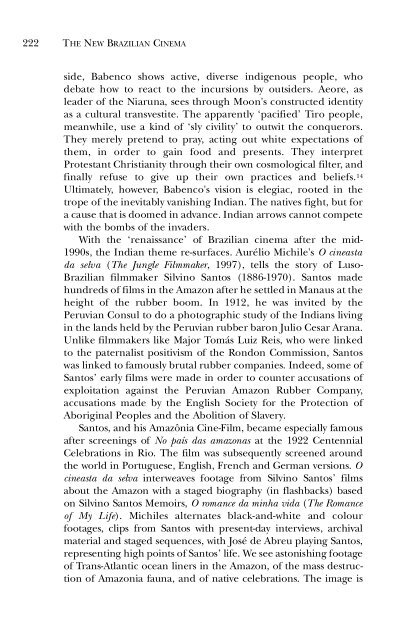Sertão
Sertão
Sertão
Create successful ePaper yourself
Turn your PDF publications into a flip-book with our unique Google optimized e-Paper software.
222<br />
THE NEW BRAZILIAN CINEMA<br />
side, Babenco shows active, diverse indigenous people, who<br />
debate how to react to the incursions by outsiders. Aeore, as<br />
leader of the Niaruna, sees through Moon's constructed identity<br />
as a cultural transvestite. The apparently ‘pacified’ Tiro people,<br />
meanwhile, use a kind of ‘sly civility’ to outwit the conquerors.<br />
They merely pretend to pray, acting out white expectations of<br />
them, in order to gain food and presents. They interpret<br />
Protestant Christianity through their own cosmological filter, and<br />
finally refuse to give up their own practices and beliefs. 1 4<br />
U l t i m a t e l y, however, Babenco's vision is elegiac, rooted in the<br />
trope of the inevitably vanishing Indian. The natives fight, but for<br />
a cause that is doomed in advance. Indian arrows cannot compete<br />
with the bombs of the invaders.<br />
With the ‘renaissance’ of Brazilian cinema after the mid-<br />
1990s, the Indian theme re-surfaces. Aurélio Michile's O cineasta<br />
da selva (The Jungle Filmmaker, 1997), tells the story of Luso-<br />
Brazilian filmmaker Silvino Santos (1886-1970). Santos made<br />
hundreds of films in the Amazon after he settled in Manaus at the<br />
height of the rubber boom. In 1912, he was invited by the<br />
Peruvian Consul to do a photographic study of the Indians living<br />
in the lands held by the Peruvian rubber baron Julio Cesar Arana.<br />
Unlike filmmakers like Major Tomás Luiz Reis, who were linked<br />
to the paternalist positivism of the Rondon Commission, Santos<br />
was linked to famously brutal rubber companies. Indeed, some of<br />
Santos’ early films were made in order to counter accusations of<br />
exploitation against the Peruvian Amazon Rubber Company,<br />
accusations made by the English Society for the Protection of<br />
Aboriginal Peoples and the Abolition of Slavery.<br />
Santos, and his Amazônia Cine-Film, became especially famous<br />
after screenings of No país das amazonas at the 1922 Centennial<br />
Celebrations in Rio. The film was subsequently screened around<br />
the world in Portuguese, English, French and German versions. O<br />
cineasta da selva i n t e rweaves footage from Silvino Santos’ films<br />
about the Amazon with a staged biography (in flashbacks) based<br />
on Silvino Santos Memoirs, O romance da minha vida (The Romance<br />
of My Life). Michiles alternates black-and-white and colour<br />
footages, clips from Santos with present-day interviews, archival<br />
material and staged sequences, with José de Abreu playing Santos,<br />
representing high points of Santos’ life. We see astonishing footage<br />
of Trans-Atlantic ocean liners in the Amazon, of the mass destruction<br />
of Amazonia fauna, and of native celebrations. The image is
















